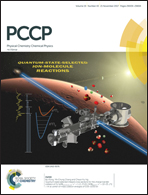The mobility of proton carriers in phosphate glasses depends on polymerization of the phosphate framework†
Abstract
Proton conducting phosphate glasses were prepared by electrochemical substitution of sodium ions with protons applied to glasses with the compositions xNaO1/2–1WO3–8NbO5/2–5LaO3/2–(86 − x)PO5/2 (x = 28, 32, 35, 38, and 40). The mobilities of proton carriers in the glasses were studied in terms of the polymerization degree of the phosphate framework. The proton mobility at 200 °C increased as the depolymerization of the phosphate framework developed up to x = 38, and decreased at x = 40. On the basis of Raman and infrared spectra measurements of the O–H stretching vibration region, the decreasing mobility at x > 38 was attributed to the increasing concentration of protons trapped by non-bridging oxygen in P2O74− ions, owing to strong O–H bonding. We found that the highly polymerized phosphate framework decreased the mobility of proton carriers, not because of suppression of the proton dissociation from oxygen atoms but rather the suppression of the proton migration. The compositions at which the phosphate framework was sufficiently depolymerized and did not contain P2O74− ions as a main component, achieved high mobility of proton carriers in phosphate glasses.



 Please wait while we load your content...
Please wait while we load your content...